 |
 |
 |
| |
Intensified peginterferon alfa-2a (40KD) dosing increases sustained virological response rates in genotype 1 hepatitis C patients with elevated low-density lipoprotein
|
| |
| |
Reported by Jules Levin
Presented at The 21st Conference of the Asian Pacific Association for the Study of the Liver (APASL), February 17-20, 2011, Bangkok, Thailand
S.A. Harrison,1 D. Abdurakhmanov,2 M.L. Shiffman,3 I. Bakulin,4 W. Mazur,5 M. Rodriguez-Torres,6 G.F. Silva,7 H. Cheinquer,8 M. Hohmann,9 F. Tatsch,10 K.R. Reddy11 on behalf of the PROGRESS investigators
1Brooke Army Medical Center, Fort Sam Houston, TX, USA; 2Moscow Medical Academy, Moscow, Russia; 3Liver Institute of Virginia, Bon Secours Health System, Newport News, VA, USA; 4State Postgraduate Medical Institute,
Ministry of Defence of the Russian Federation, Moscow, Russia; 5Medical University of Silesia, Chorzow, Poland; 6Fundacion de Investigacion De Diego Santurce, Santurce, PR, USA; 7Botucatu School of Medicine, Botucatu, Brazil;
8Hospital de Clinicas de Porto Alegre, Porto Alegre, Brazil; 9IST GmbH, Mannheim, Germany; 10Roche, Basel, Switzerland; 11University of Pennsylvania, Philadelphia, PA, USA
"Patients with elevated LDL levels had consistently higher virological response rates at week 4 (RVR; Figure 2a), week 12 (cEVR; Figure 2b), and week 48 (EOT; Figure 2c) compared with patients with low LDL levels. With the exception of the standard-dose group (A), SVR rates were also consistently higher (Figure 3a) and relapse rates consistently lower (Figure 3b) in patients with elevated LDL levels compared with those with low LDL levels. Among patients with elevated LDL levels, SVR rates were significantly higher in the two induction-dosing groups (C and D) compared with the standard-dose group (A) (Figure 3a)...... relapse rates were significantly lower in the two induction-dosing groups (C and D) in patients with elevated LDL levels, compared with the standard-dose group (A) (Figure 3b). Multiple logistic regression (MLR) analysis identified a significant interaction (p=0.011) between intensified peginterferon alfa-2a (40KD) dose and LDL on SVR rates"
----------------------------------
AASLD2010: IL-28B Genotype is a Major Determinant of the Induction of a Virological Response by High-Dose Peginterferon and Ribavirin in Null-responders to SOC Therapy: Pegasys double-dose significantly increased early virologic response - (12/13/10)
"Using double dose Pegasys in this study appeared to on average increase the virologic response quite a lot by weeks 4, 8 and 12 compared to prior use of the standard Pegasys dose for both TT and CT genotypes. CT genotype achieved better virologic response than TT genotype in this study, by week 24: 44% of TT and 70% of CT achieved >2 log viral load reduction. These data suggest that double-dose Pegasys 360 ug/week in combination with telaprevir or boceprevir may significantly increase virologic response and SVR. Conceivably, double-dose Pegasys during a lead-in and during therapy with telaprevir or boceprevir could increase SVR rates potentially quite a lot based on these data. There is a suggestion that an HCV protease resenesitizes the patient's internal interferon response so let's see how the TTs and CTs respond in the subanalyses from Advance & Sprint."
--------------------------------------
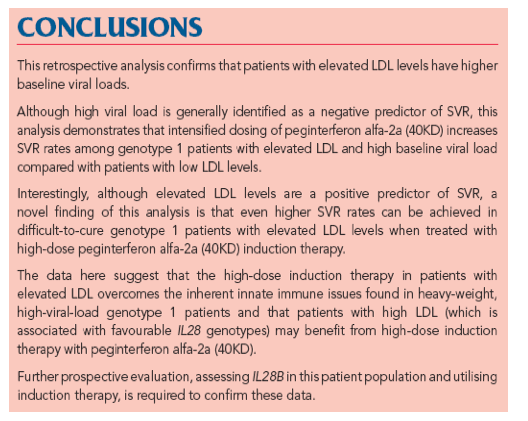
INTRODUCTION
The hepatitis C virus (HCV) interacts with serum lipoproteins and lipoprotein
receptors. Such associations may help the virus evade the host immune response.[1-3]
In untreated patients with chronic hepatitis C, HCV viral load increases with expression of low-density lipoprotein (LDL) receptor,[4] supporting the hypothesis that the LDL receptor is one of several potential host factors that can mediate attachment and entry of the virus into hepatocytes.
Moreover, IL28B polymorphisms (non-CC genotypes) have been reported to be
associated with lower LDL levels.[5]
Patients infected with HCV who have elevated LDL levels have been reported to
achieve higher sustained virological response (SVR) rates following treatment with peginterferon plus ribavirin compared to patients with lower LDL levels.[6,7]
It is not currently clear whether SVR rates in patients with low or elevated LDL levels can be improved by dose intensification. The recently completed double-blind, randomised, international PROGRESS study provides an opportunity to address this question.[8]
OBJECTIVE
This retrospective analysis of data from PROGRESS compared SVR rates in patients with low and elevated fasting LDL levels to determine whether dose intensification can increase SVR rates in patients with difficult-to-cure characteristics.

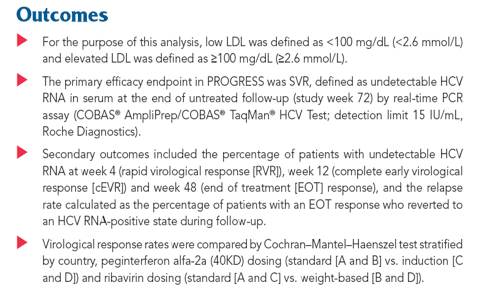
RESULTS
Fasting LDL data were available for 537 patients: 271 with low LDL levels (mean 74 mg/dL) and 266 with elevated LDL levels (mean 126 mg/dL) (Tables 1a and 1b).
Baseline characteristics were similar in patients with low and elevated LDL levels and within each treatment arm (Tables 1a and 1b), with the exception of mean baseline HCV RNA level; patients with elevated LDL had higher baseline HCV RNA (n=266; 6.0 x 106 IU/mL) versus patients with low LDL (n=271; 4.2 x 106 IU/mL).
A similar number of patients with low (n=9, 3.3%) and elevated (n=10, 3.8%) LDL levels were on statins (and other lipid-regulating agents).
Patients with elevated LDL levels had consistently higher virological response rates at week 4 (RVR; Figure 2a), week 12 (cEVR; Figure 2b), and week 48 (EOT; Figure 2c) compared with patients with low LDL levels.
With the exception of the standard-dose group (A), SVR rates were also consistently higher (Figure 3a) and relapse rates consistently lower (Figure 3b) in patients with elevated LDL levels compared with those with low LDL levels.
Among patients with elevated LDL levels, SVR rates were significantly higher in the two induction-dosing groups (C and D) compared with the standard-dose group (A) (Figure 3a).
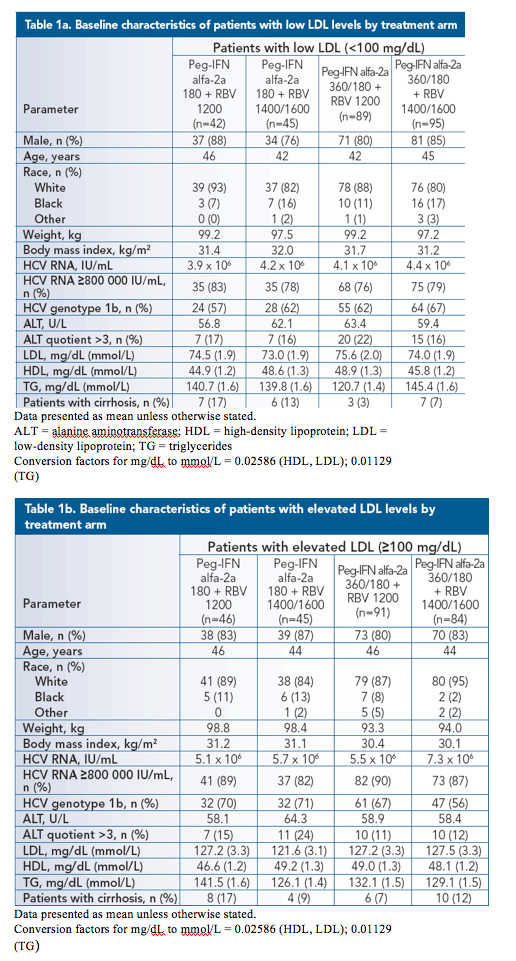
In addition, relapse rates were significantly lower in the two induction-dosing groups (C and D) in patients with elevated LDL levels, compared with the standard-dose group (A) (Figure 3b).
Multiple logistic regression (MLR) analysis identified a significant interaction (p=0.011) between intensified peginterferon alfa-2a (40KD) dose and LDL on SVR rates.
A nested MLR model, applied to estimate the treatment effect within the two LDL groups, identified the following factors to be significantly associated with SVR: younger age (p=0.0001 for ≤40 vs. >40 years), infection with HCV genotype 1b (p=0.001 vs. genotype 1a), low steatosis score (p=0.007 for <5% vs. ≥5%) and low viral load (p=0.007 for HCV RNA <800 000 vs. ≥800 000 IU/mL) (Figure 4). A significant relationship was also identified between treatment and SVR in patients with elevated LDL (arm C vs. A: p=0.005; and arm D vs. A: p=0.004); such a relationship was not observed in patients with low LDL. Thus, the results of the Cochran-Mantel-Haenszel analysis (Figure 3b) are confirmed by the MLR analysis after adjusting for predictive baseline characteristics (e.g. HCV RNA level at baseline).
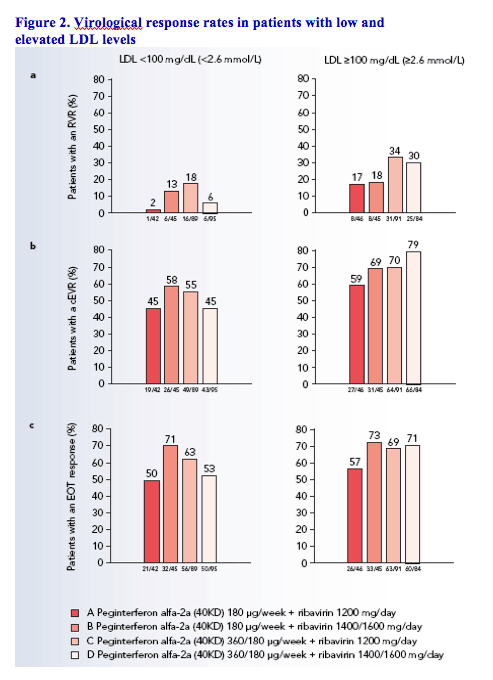
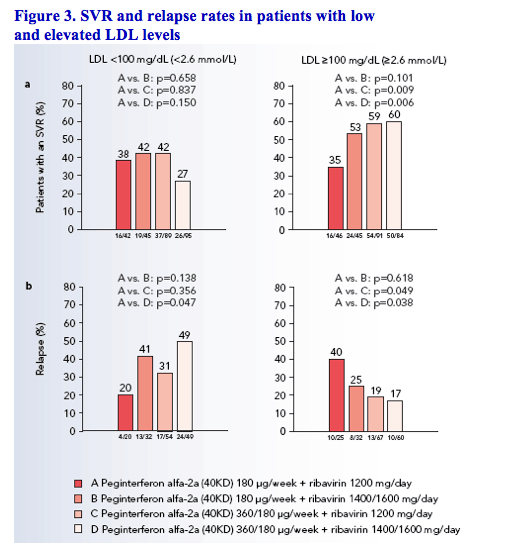
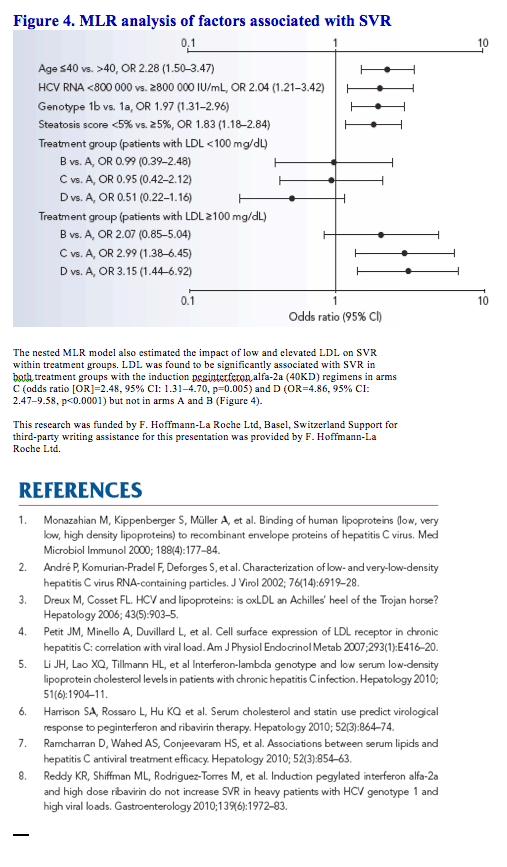
|
| |
|
 |
 |
|
|